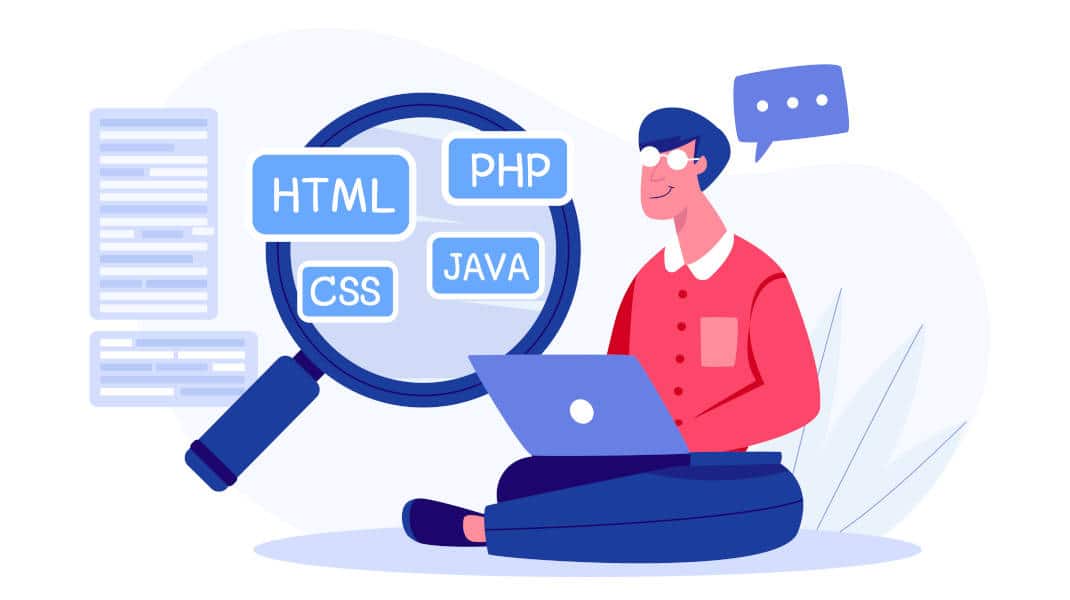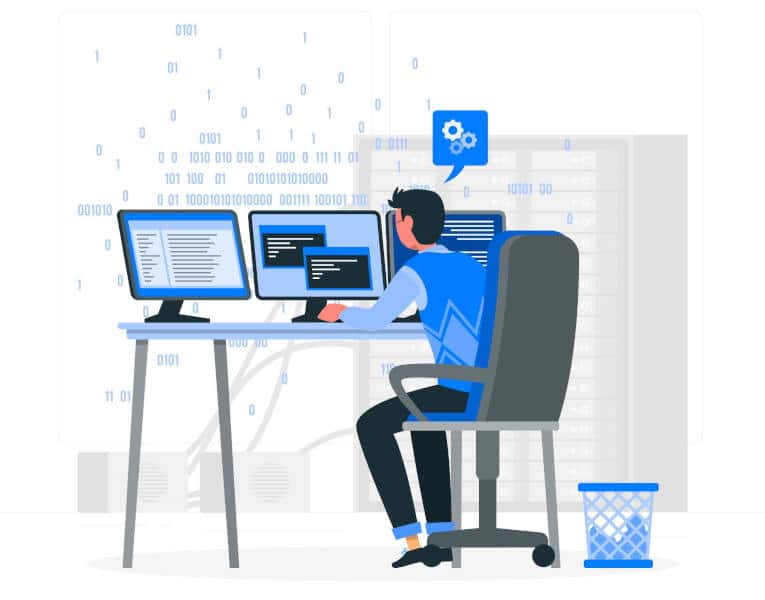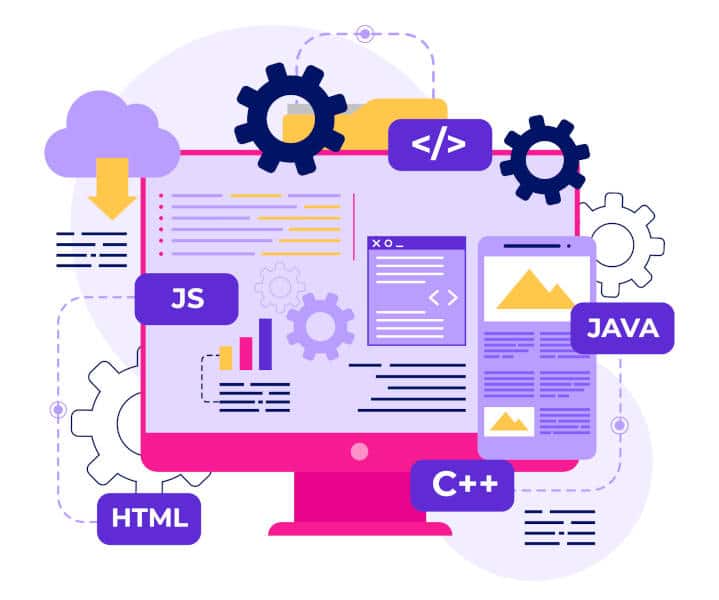Web development courses will enable you to acquire all the skills needed to program websites or web applications: an expertise that is in great demand at a time when digital technology is becoming omnipresent in our lives! Find out everything you need to know about this type of course, and how to give yourself the best chance of success!
While there were just over 155,000 websites in 2008, there will be over a billion by 2023, according to NetCraft. Since it first appeared in 1991, the Internet has undergone a veritable boom, with 3 new websites being created every second.
Against this backdrop, the digital world has created an unprecedented demand for web development professionals. Companies in all sectors are looking for experts who can bring their website or application projects to fruition.
Whether you’re an IT enthusiast or looking to start a career in this field, web development is the way to go. However, to learn how to handle all the necessary tools, training is essential!
What is web development? Understanding the basics duing Web development courses
To understand this, we need to go back to the basic principles of how the Internet works.
Servers host websites and supply data, while clients (web browsers) make them accessible to users.
The hypertext transfer protocol (HTPP, HTTPS) ensures the exchange of information between client and server. These elements form the backbone of the technology we use every day.
Put simply, web development is the art of creating applications and websites that work smoothly and efficiently.
It encompasses a range of tasks and skills aimed at creating interactive and functional web applications: user interface design, front-end and back-end development, database management, etc.
This branch of development is based on specific programming languages. HTML (HyperText Markup Language) defines the basic structure of a web page using tags.
CSS (Cascading Style Sheets) is used to style and format HTML elements for a visually appealing appearance. Finally, JavaScript makes web pages dynamic and interactive.
So web developers are the architects of the digital world, turning ideas into pages, sites and applications. Let’s take a look at the skills they need to have!

The main skills of a web developer
Choosing the right web developer course means understanding the different specialisms that exist. The main divide is between front-end and back-end.
The front-end is responsible for the user interface visible to users, and involves the use of languages such as HTML, CSS or JavaScript.
There are also frameworks that simplify web development work. These include React, Angular and Vue.js for the front-end, designed to facilitate the creation of interactive user interfaces.
The back-end, on the other hand, manages the invisible aspects of the site, such as database management and query processing. It is based on languages such as Node.js, Python or Ruby.
Back-end frameworks include Node.js, Django (Python) and Ruby on Rails (Ruby) to speed up server-side development.
However, developers don’t necessarily have to choose between these two dimensions of the web. They can also go down the “full-stack” route, combining front-end and back-end!
At the same time, tools such as SQL and MongoDB enable interaction with relational or non-relational databases. All these concepts must be mastered by the developer, but there is much more to it than that…
Web development workflow tools and technologies
To optimise their workflow and collaborate effectively with other professionals, web developers need to master a whole range of tools and technologies.
It all starts with choosing a development environment (IDE) suited to your preferred programming language. Among the most popular are Visual Studio Code, Atom and Sublime Text.
There are also extensions and plugins that allow you to customise the environment to increase productivity.
Modern developers also use version control systems such as Git to track changes to source code, and hosting platforms such as GitHub and GitLab for collaboration.
Communication also involves dedicated platforms such as Slack, or Trello for organising tasks and tracking project progress.
All these solutions save precious time and maximise the quality of sites and applications… but they would be nothing without the adoption of best practices, which we will discuss in the next chapter.
Web development in the field of Data Science
In the field of Data Science, web development is used in particular to create tools and techniques for visualising data interactively. This makes it easier to understand trends and the results of analyses.
Developers can also integrate data-based functionalities into applications, such as interactive dashboards, recommendation systems or real-time analysis applications.
A data scientist can create predictive or analytical models that are then integrated into web applications via APIs, which enable data science capabilities to be used to offer advanced functionality to users.
Machine Learning algorithms are also frequently used by web applications to recommend content and products, or to offer specific services to individual users based on their preferences and behaviour.
Web developers also play a crucial role in creating robust infrastructures for storing, processing and analysing data. They are responsible for designing systems to manage large quantities of data efficiently and securely.

How can I train effectively in web development?
There are various options open to you for becoming a web developer, and you need to choose the path that suits you best. While university programmes offer a solid theoretical grounding in IT concepts, they have the disadvantage of being long and often expensive.
In contrast, a BootCamp offers a more modern approach with an intensive programme aimed at quickly acquiring the skills needed to enter the job market.
They are practically oriented and often more affordable than university courses. To complement such online training, you can also consult free tutorials on YouTube or other platforms to perfect your mastery of the tools!
Web development is all about practice. Practical experience is therefore crucial for consolidating your knowledge and demonstrating your skills to potential employers.
This can involve taking part in open source projects, so that you can apply your theoretical skills and build up an impressive portfolio. You can also develop your own website, application or even a simple blog.
These projects will help you prove your skills when looking for a job and show your commitment. However, choose the projects you include in your portfolio carefully to emphasise the diversity of the skills you demonstrate.
Adopting best practice: the ideal way to stand out from the crowd
There are many web developers, but there are certain practices that can make all the difference and allow you to stand out from the crowd.
They guarantee the quality of the code, the security of the web application and the fluidity of the user experience. That’s why it’s in your interest to adopt them.
First of all, test-driven development involves writing unit tests before the code to ensure reliability and facilitate maintenance.
You also need to master the test frameworks adapted to your programming language, such as Jest for Javascript or Pytest for Python.
What’s more, at a time when the mobile is becoming the main device used to go online, a modern application must be adaptable thanks to “Responsive Design” techniques.
CSS media queries, for example, can be used to create dynamic page layouts according to screen size. Whatever the device used, the application will be displayed optimally on the screen.
Another priority is cyber-security, as cyber-attacks on web applications are exploding to unprecedented levels. Protocols such as HTTPS have become essential for guaranteeing data confidentiality.
In addition, developers need to be familiar with code security practices such as input validation, protection against XSS and CSRF attacks and session management.

Finding a job after Web development courses: top tips
As a collaborative discipline, web development is an area where it makes sense to make connections with other members of the community. This is perhaps as important as acquiring skills.
To build your network, you can attend meetups, conferences and other events. These are great opportunities to meet other developers, share experiences and keep up to date with industry trends.
You should also make use of social networks by creating a professional profile on platforms such as LinkedIn and Twitter to share your achievements and knowledge and make connections.
Don’t hesitate to take part in online discussions, or follow relevant hastags to stay connected with the community. Forums such as Stack Overflow, Reddit or Discord are also great networking tools.
To find a job, take care with your CV by structuring it in such a way as to highlight your technical skills and achievements. Demonstrate your experience with examples of your projects.
Mention your training, as well as any relevant qualifications you have obtained. Prepare for your interviews by reviewing the basics and practising solving frequently asked technical problems.
Throughout your career, even once you’ve been hired, keep up to date with the latest trends and technologies by following blogs, podcasts or attending webinars.
You need to keep training to continue your professional development so that you can progress in your career and keep up to date with new development technologies!
Conclusion:Web development courses - a passkey for the digital age
After completing a web developer course, you’ll be able to write lines of code or develop interfaces to create websites and applications in line with customer specifications.
This is a highly valuable skill at a time when companies in all industries now have their own websites and applications for use internally or deployed to the public.
To acquire this expertise, you can choose DataScientest! Our distance learning courses will teach you to master the Python language, the various development tools, databases and the main cloud computing platforms such as AWS, Google Cloud and Microsoft Azure.
All our courses can be completed entirely by distance learning, leading to a state-recognised diploma and cloud certification. You can complete our courses by BootCamp, continuing education or sandwich courses, and our organisation is eligible for funding options! Discover DataScientest!

You now know everything there is to know about web developer training. For more information on the same subject, check out our dossier on the Python language, and our complete dossier on databases!










